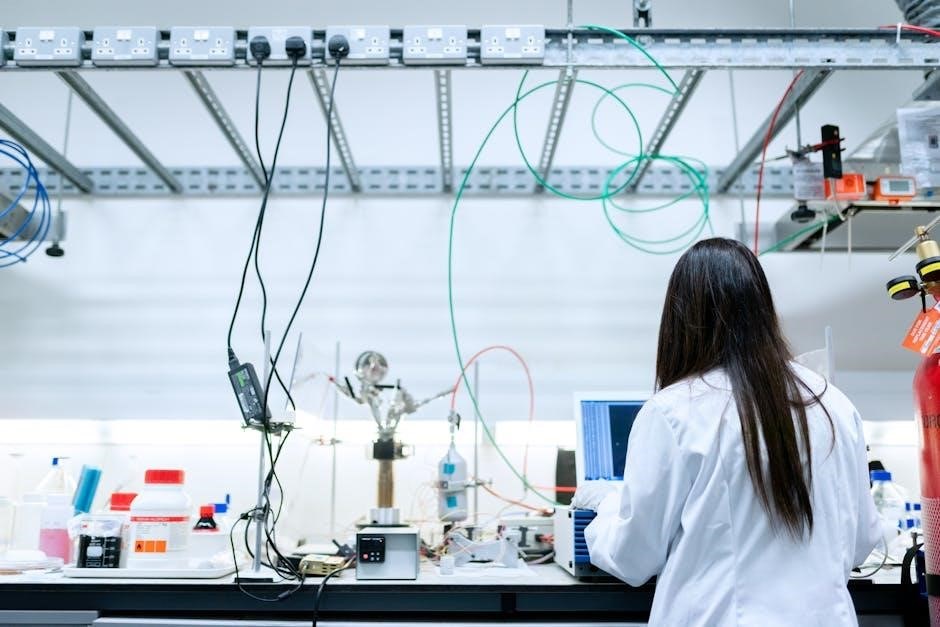The Beaks of Finches Lab introduces students to natural selection‚
- using tools to simulate finch beaks
and explore adaptation‚ with answers available in PDF format for easy reference and student assessment purposes always online.
Lab Objectives and Key Concepts
The lab objectives include understanding natural selection‚ the importance of variation‚ and adaptive traits and environmental pressure‚ which are essential concepts in the Beaks of Finches Lab.
Students will learn about the different characteristics of finch beaks and how they adapt to their environment‚ using tools to simulate the beaks and seeds.
The key concepts of the lab are introduced through a series of activities and questions‚ allowing students to think critically about the material and apply their knowledge to real-world scenarios.
The lab also provides opportunities for students to analyze data and draw conclusions‚ developing their scientific skills and knowledge.
By completing the lab‚ students will gain a deeper understanding of the natural selection process and how it affects the evolution of species‚ with the answers to the lab questions available in PDF format for easy reference.
The lab objectives and key concepts are designed to align with national science standards‚ ensuring that students receive a comprehensive education in the subject.
Overall‚ the Beaks of Finches Lab is an engaging and educational experience that provides students with a unique perspective on the natural world‚ using a combination of hands-on activities and online resources‚ including the lab answers in PDF format;

Materials and Tools
Various tools and seeds are provided to model finch feeding‚ including tweezers‚ clips‚ and other objects to simulate beaks‚ available with lab answers in PDF format for easy reference online.
Predicting Beak Success
Students are asked to examine the different tools and seeds provided to model a finch feeding‚ and predict which beak will be the most successful at picking up small seeds‚ giving reasons for their choice.
This prediction is based on the characteristics of the beaks‚ such as size‚ shape‚ and material‚ and how they relate to the seeds‚ including size‚ shape‚ and texture.
Students should consider how the beak’s shape and size will affect its ability to pick up and hold onto the seeds‚ and which beak will be the least successful‚ providing explanations for their predictions‚ all guided by the lab answers in PDF format.
By analyzing the beaks and seeds‚ students can develop an understanding of how different traits can influence an organism’s ability to survive and thrive in its environment‚ and apply this knowledge to real-world scenarios‚ with the lab answers providing a comprehensive guide to the experiment.
The prediction of beak success is a critical component of the lab‚ as it allows students to think critically about the relationship between traits and environment‚ and to develop hypotheses that can be tested through experimentation‚ all supported by the lab answers in PDF format online.

Adaptive Traits and Environmental Pressure
Students are introduced to adaptive traits and environmental pressure‚
- exploring how finches adapt
to their environment through natural selection‚ with lab answers in PDF format providing guidance and support always available online easily.
Analysis Questions

Beaks of Finches Lab Answer Key
The answer key is available in PDF format‚ downloadable online for easy reference and grading purposes always.
Finch Species Survival
The survival of finch species is closely tied to their ability to adapt to their environment‚ with different beak shapes and sizes allowing them to access various food sources.
In the Beaks of Finches Lab‚ students can model this process by using different tools to simulate finch beaks and competing for seeds‚
with the most successful beaks being those that are best adapted to the available food sources.
A key factor in finch species survival is the ability to find and eat seeds‚
with different species having evolved unique beak shapes and sizes to access different types of seeds.
The lab activity allows students to explore this concept in a hands-on way‚
using data and analysis to determine which beak shapes and sizes are most successful in different environments.
By examining the characteristics of different finch species and their beaks‚
students can gain a deeper understanding of the importance of adaptation in determining species survival.
This knowledge can then be applied to real-world scenarios‚
such as understanding how changes in the environment may impact different species and their ability to survive.
The Beaks of Finches Lab provides a comprehensive and engaging way to explore this important concept.
The Beaks of Finches Lab concludes with students understanding natural selection‚ using tools and seeds to simulate adaptation‚ with answers in PDF format for easy reference and assessment purposes always available online now.
Additional Resources
For further learning‚ students can access online resources‚ including PDF files and educational websites‚ to explore the Beaks of Finches Lab in more depth. These resources provide additional information on natural selection‚ adaptation‚ and the importance of variation in finch populations.
- Some resources include
video tutorials‚ interactive simulations‚ and downloadable worksheets‚ all designed to enhance student understanding of the lab’s key concepts.
- Online resources may also offer
extensions and modifications for the lab‚ allowing teachers to tailor the activity to their students’ needs and abilities. By utilizing these additional resources‚ students can gain a more comprehensive understanding of the Beaks of Finches Lab and its relevance to real-world biology and ecology.
Teachers can also use these resources to develop assessment tools‚ such as quizzes and exams‚ to evaluate student learning and understanding of the lab’s objectives and key concepts.

Lab Activity Evaluation
Evaluation of the lab activity involves assessing student understanding of natural selection‚ using tools like
- quizzes
and exams to measure knowledge and skills always online effectively.
Extensions and Modifications
To extend the lab activity‚ teachers can incorporate additional elements‚ such as having students design and test their own beak tools using various materials‚ or exploring the impact of environmental changes on finch populations. This can be achieved by providing students with a variety of materials‚ such as cardboard‚ straws‚ and tape‚ and asking them to create their own beak tools. Students can also research and discuss the different types of beaks found in various finch species and how they are adapted to their environments. Furthermore‚ teachers can modify the lab activity to accommodate different learning styles and abilities‚ such as providing visual aids or offering one-on-one support. By incorporating these extensions and modifications‚ teachers can create a more engaging and inclusive learning experience for their students. The lab activity can also be extended to include a discussion on the importance of conservation and the impact of human activities on finch populations. Overall‚ the extensions and modifications can enhance the learning experience and provide students with a deeper understanding of the topic. The use of online resources‚ such as the beaks of finches lab answers pdf‚ can also provide teachers with additional support and guidance.
